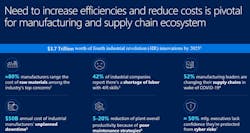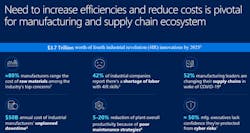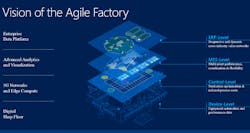How AI and cloud analytics are unlocking new maintenance insights
Kim Custeau, asset performance business unit leader for AVEVA, has over 30 years of experience in industrial asset management software and services. Neal Meldrum, global business strategy leader for Microsoft’s Manufacturing and Resource Group, has over 20 years of experience with industrial equipment, operational technology and cloud solutions in the manufacturing and automation marketplace. During the live Q&A portion of the webinar, "How to Maximize Operational Efficiency with Cloud and AI," Custeau and Meldrum discussed digital trends driving the factory of the future.
PS: Do I need to replace my existing manufacturing systems to begin using cloud technology in my industrial business?
KC: The answer to that is no. One of the tenets from the AVEVA perspective certainly is to leverage existing investments. And there are very good use cases where there are some software solutions that remain on-premise, like hybrid solutions, and they're still interconnected to the cloud. A good example is analytics: it makes a lot of sense to do that in the cloud.
There's a good reason to leverage the investments customers have made and start the journey at places where it makes a lot of sense for that customer to have their information or their applications in the cloud, and then it will grow from there.
NM: We like to take standard space approaches towards deployment, so leveraging OPC-UA when possible. This allows us to bring data context early. And also leveraging tools like data historians, oftentimes through aggregation across ERP, can bring insights very quickly.
Clearly, we can build on top of our existing infrastructure line solutioning. What’s very important in manufacturing is the ability to bring some of these capabilities to the edge as part of that, so there's a broad portfolio of capabilities there and allied solutioning as well.
PS: How much integration does the APM need, so your EAM and CMMS system, like Maximo, for example?
KC: There’s two different purposes there, your EAM systems, your Maximo systems, are your system of record; applications like AVEVA Insight are doing the analysis around asset performance. What we want to be able to do is ensure that we've got alignment between the two systems in terms of assets.
The day-to-day integration between the two would be, as we uncover a potential challenge that we think that maintenance needs to look into, or, as we are watching the real-time data, we want to be able to push through an integration, so they would create a work request, or a work order in the target system. In this case, the questions around Maximo, we want to be able to create a work order that will mobilize somebody from records to be able to do that work.
And then Insight, as an APM solution, could also then be where they could see visualization on that, where they can see the trending and information about the assets, and the maintenance management system is normally then the system of record, right, that tracks those work orders. The integration is really at that level.
PS: What internal organizations, in your opinions, need to be involved to make sure that technology adoption is successful? And what kind of training would you put in place to make that happen?
NM: The change management element in driving these engagements are a huge challenge. But what we see in best practices, in leveraging some of the technologies, are things like creating digital repositories with related information, and leveraging cognitive search to more agilely bring that information to life, troubleshooting, accelerated troubleshooting, and so forth, as part of that. Leveraging tools like mixed reality, or augmented reality, we see higher levels of adoption and retention of information because of such an immersive experience.
An interesting study we did around safety training and leveraging mixed reality, we saw five times improvement in information retention. Also regarding cultural adoption, we want to generate and try and drive inclusiveness. If you think about all the domain expertise that lives on top floor with first-line workers, but also operators, and managers, it's culturally, it's important to drive towards an inclusive engagement.
KC: If there's so much knowledge in the workforce itself, crowdsourcing data and information about what's going on in the plant floor is also something we're seeing, where you can build out collaboration tools, and that becomes part of the training or the knowledge management system.
PS: Where do customers typically see the quickest ROI when implementing AI in cloud technologies?
KC: One thing that I've seen personally is, when you focus on a specific problem, don't try to boil the ocean. If you have a specific area or a problem, challenge area, and you focus there and really understand by leveraging AI basically as a new lens over the information that you're reviewing, then I think that's where you're going to see the fastest return because you're focused on solving a specific problem.
Once you do that, and you see the return from that, the return can then fuel bigger and bolder attempts at other problems that you have. Start small, breed success. Then from that success, it opens up opportunities for both funding, and also greater outcomes for the company.
NM: I would agree. We always say don't select the biggest problem. It's part of your journey, but it's driven around broader IT/OT assessment and looking at where some of the key pain points lie. Some of the simplest things like calculation of OEE oftentimes we find through aggregation across disparates so we can drive towards more efficiency, and then later on that predictive strategy.
PS: How do you see businesses leveraging their own big data to improve their operations?
NM: Operational visibility is an interesting discussion, because we see through the abstracted number of data systems, operational systems, oftentimes creating this big data strategy, and then building a presentation layer as a starting point is a really interesting piece of the journey because you can build out dashboards relevant to the insights you're driving to, via time-series data or other extracted sources. We see this as a foundational piece to the journey.
KC: There is no shortage of data, right? But I think what AI is able to do, and also, certainly through the cloud, is give you a new lens on that data. A different perspective, and a different way of looking at it, will drive new ways of thinking about problem-solving. The richness in the data that has already been captured, it can just be unlocked.


